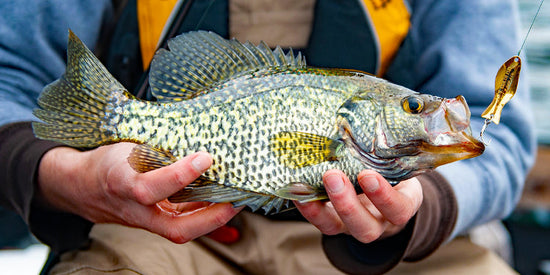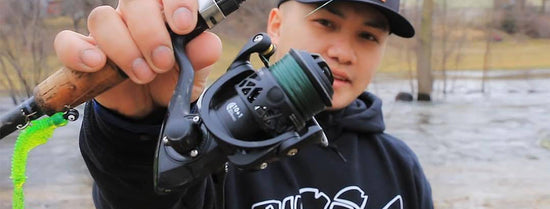LiveScoping Cold Water Crappie
What all started with a nice early spring day in Wisconsin looking for cold water largemouth, quickly turned into a very eventful day catching cold water Crappie. Water temps were anywhere from 38 degrees, up to 46 degrees. My friend Lukas and I were fishing “The Hole '' utilizing my Garmin Livescope looking for Bass roaming anywhere from 10-25 feet of water. After a quick look around with the livescope, something caught my eye. Schools of Crappie all over! Most schools we saw were anywhere from ten all the way up to a hundred fish at a time!
Finding Suspended Cold Water Crappie
The Crappies we were finding were suspended somewhere between six and eighteen feet of water and moving quickly. This is where things got fun! I grabbed my Piscifun Carbon X and tied up a Slip Bobber rig. This consisted of a slip knot, bead, bobber, split shot sinker, and a very small hook. Fortunately on the way to the lake, Lukas talked me into picking up minnows ‘’just in case’’. I’m glad we did! We started following the first school. We were in 23 feet of water, and this school of Crappie was suspended in 15 feet of water. We set the slip bobbers and casted on top of the school. We quickly realized on LiveScope that our minnow was only ten to eleven feet down and the Crappie were not willing to swim up for the bait.

Precision Bait Placement with Livescope
After a quick adjustment of the Slip Bobber, we quickly got our first bite! The bobber went sub-surface and we gave it a five count. BOOM! Fish on, and it was a big Crappie. The silky smooth drag of the Piscifun Carbon X was in action. Using LiveScope we found that we needed to place our minnow directly in the middle of the school. If the minnow was 5 feet off in any direction, you weren’t getting bit.
The Thrill of Light Tackle Panfishing
Fighting big panfish on ultralight gear is a blast. Having a lightweight reel with a smooth drag is critical to finessing these fish to the boat. Thanks to the Carbon X, this is easily accomplished. The cold water had these fish in GO Mode. The Crappie were aggressive fighters. Pulling drag and putting up a fight before hitting the net. After we would catch a few fish, the school would move on and we would be forced into trolling around “The Hole” and finding new and hungry schools. After an hours worth of fishing, we managed to put 15 Crappie in the LiveWell for dinner, and let the rest of the big girls go.
The Importance of Timing the Bite Window
We noticed that the Major bite window played a huge part in the bite. Once that ended and the Sun became high in the sky, these fish were a lot harder to catch. After the bite became almost non-existent, we started trolling around looking for active schools again. The fish were still around, but not nearly as schooled up, much closer to the bottom, and not willing to bite! We scraped together a few more fish before the North Wind picked up and made the fishing very cold and less fun.
Spring Panfishing Patterns
There are many different ways to catch panfish in the spring. You can find spawning fish moving into warmer water. Warmer water is usually found in Creeks, Canals, and Harbors. If there is moving water with food, they will often be found there too. However this was a special kind of way to catch them that quickly became my favorite. Without my Garmin LiveScope and my Piscifun Reel, I don’t believe we would have had nearly the success we did.

Write to the End
As I write this article, I am preparing for a big snow storm and the boat is tucked away in storage yet again! The snow will cool off the water, possibly freezing back over. We will start the process all over, chasing big panfish all over. Wisconsin is an awesome place to fish, with lots of potential for awesome days on the water. But with the good, comes the bad. Praying for warmer days ahead.


